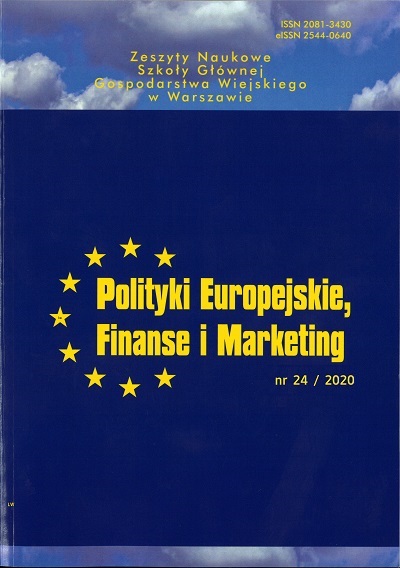Main Article Content
Article Details
Bernat, T., Hawran, K., Kowalik, J., Asymmetry information model principal-agent – results of experiments, Przedsiębiorstwo i Region, 2016.
Core & More. An opportunity for smarter corporate reporting, September 2017 https://www.accountancyeurope.eu/wp-content/uploads/170918-Publication-Core-More.pdf (accessed on 19 May 2019)
Core & More in practice, https://www.accountancyeurope.eu/publications/core-more-in-practice/ (accessed on 19 May 2019 )
Dziawgo, D., "New" Financial Statement - a Voice in the Discussion, Theoretical Journal of Accounting, 2011.
Espejo, M., Daciê, F., Reducing information asymmetry from the management control perspective: discussion of practices in transparent companies. Revista Contabilidade & Finanças, 2016. (Crossref)
Fox, J., Lorsch, J. W. What good are shareholders?. Harvard Business Review, 2012, 90(7/8).
Follow-up Paper. “The Future of Corporate Reporting –creating the dynamics for change”, March 2017 https://www.accountancyeurope.eu/wp-content/uploads/170322-Publication-Follow-up-paper-on-FoCR.pdf (accessed on 19 May 2019)
Hąbek, P., Corporate social responsibility as a stakeholder – oriented conception. Organization & Management Scientific Quarterly, 2009.
Healy, P. M., Palepu, K. G., Information asymmetry, corporate disclosure, and the capital markets: A review of the empirical disclosure literature. Journal of accounting and economics, 2001. (Crossref)
Hockerts, K., Moir, L., Communicating corporate responsibility to investors: The changing role of the investor relations function. Journal of Business Ethics, 2004. (Crossref)
Jaworska, E., Change in the approach to reporting in the context of corporate social responsibility. Finance, Financial Market, Insurance, 2011.
Krasodomska, J., Non-financial Information as Part of a Company Annual Report. Cracow Review of Economics and Management, 2010.
Lambert, R., Leuz, C., Verrecchia, R. E., Accounting information, disclosure, and the cost of capital. Journal of accounting research, 2007. (Crossref)
Łukasik, G., Conflict of interest in the corporate finance (issues for discussion. Studia Ekonomiczne, 2018.
Materska, K., Januszko, W., Distortion of information in wide area systems of economic information, Przegląd Biblioteczny, 2006.
The information obligations, https://www.gpw.pl/obowiazki-informacyjne (accessed on 3 May 2019 )
Piecuch, T., Information in the Functioning of Contemporary Enterprises. Modern Management Review, 2013.
Renier, B., & Blomme, H. Smarter corporate reporting with Core & More, The Reporting Times, 12/2018.
Rosenbrand, M., The advantages of Core & More reporting, https://www.f19.nl/en/core-more (accessed on 12 May 2019).
The Ordinance of the Minister of Finance of 29 March 2018 on current and periodic information, Dz.U. 2018 poz. 757,art. 70.
Regulation (EU) no 596/2014 of the European Parliament and of the Council of 16 April 2014 on market abuse (market abuse regulation) and repealing Directive 2003/6/EC of the European Parliament and of the Council and Commission Directives 2003/124/EC, 2003/125/EC and 2004/72/EC, art. 7
Śnieżek, E., Wiatr, M., Reflections on contemporary forms of communication with stakeholders. Studia Ekonomiczne/Uniwersytet Ekonomiczny w Katowicach. Współczesne Finanse, 2017.
Świderska G. K., 2011, Annual Report in communication with investors, http://www.pte.pl/1184_praktycznateoria.html (accessed on 3 May 2019 )
Świderska, G. K., & Bek-Gaik, B., Where does business reporting head. Studia Ekonomiczne, 2016.
Świderska, G. K., Pielaszek, M., Borowski, S., Investor Protection and Level of Disclosures by Public Listed Companies. Theoretical Journal of Accounting, 2010.
The Future of Corporate Reporting –creating the dynamics for change, FEE, October 2015, https://www.accountancyeurope.eu/wp-content/uploads/FEECogitoPaper_-_The FutureofCorporateReporting.pdf (accessed on 19 May 2019)
Act of 29 July 2005 on public offer and conditions for introducing financial instruments to organized trading system and on public companies Dz. U. z 2019 r. poz. 623, art. 56.
Walińska, E., & Gad, J., The key corporate reporting tools in the practice of the Polish capital market – case study. Theoretical Journal of Accounting, 2017.
Wysłocka, E., The role of information and financial reporting in the assessment of investment risk. Finance, Financial Market, Insurance, 2013.
Downloads
- Marzena Lemanowicz, Przejawy zachowań prosumpcyjnych konsumentów na rynku żywności , Zeszyty Naukowe SGGW, Polityki Europejskie, Finanse i Marketing: Nr 24(73) (2020)
Możesz również Rozpocznij zaawansowane wyszukiwanie podobieństw dla tego artykułu.

Utwór dostępny jest na licencji Creative Commons Uznanie autorstwa – Użycie niekomercyjne 4.0 Międzynarodowe.





